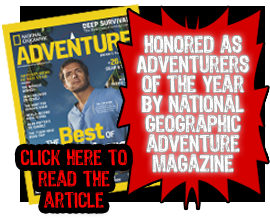On our way to Sofia, we stopped for a few days in Polvdiv… a lively town full of history and culture. We had the chance to check out some Roman ruins and get a little bit of work done before pushing on to the country’s capital.
New Photos – Svilengrad, Bulgaria
By Steve Bouey in
Bulgaria was our first entry point into the EU and we were surprised to find it packed with random excitement. We met a guy working at the border,who invited us back to his house to celebrate St. Nikolas day with his family. The night turned into a event filled with food, entertainment and some brief lessons in Bulgarian history. It was refreshing to know that even though we had entered Europe, the random encounters we have had throughout the expedition were far from over.
More Stats From The Road…
By Steve Bouey in
Getting into Africa has eased the burden on our pocketbook to a certain extent. Hopefully the days of six dollar and eight dollar per gallon fuel are in our rearview mirror. Fuel is still a little bit on the expensive side for our own liking here in Africa, but at least we hit a tax free zone in Western Sahara and were able to cut down our our consumption costs. Unfortunately, when one problem seems to be resolved, another one presents itself. Believe it or not, leaded gas is still in use throughout many parts of Africa even though it was phased out in the US decades ago. In some parts, leaded fuel is the only option aside from diesel… say for instance the entire country of Mauritania. Fortunately, we are able to carry about 400 liters of fuel and have only had to use leaded for a tank or two so the catalytic converters should not be effected too much.
Sand, Sand, And More Sand
By Steve Bouey in
What else would you expect when you are in the middle of the Sahara Desert? All of us knew that we would encounter lots of sand as we drove through the western part of the Sahara on our way across Mauritania, but I do not think any of us would realize just how much sand we would come into contact with… literally. Thanks to our friend Paul (AKA – Soloride) TWBR is now equipped with a GPS device. The GPS unit helped Paul navigate his way around the perimeter of the United States and we were confident that it would help us navigate our way through a 250 kilometer stretch of the Sahara Desert… all off-road. After a 24 hour cram session on how to use the GPS, we plotted our way points and headed off into the sand.
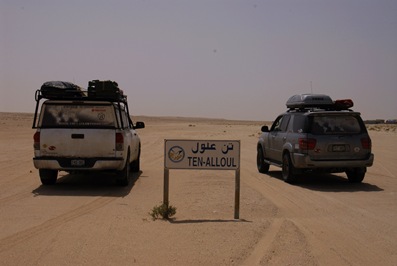
There is actually supposed to be a town here?
When we actually did stop at what the GPS unit told us was the turnoff for the “beach run,” I could not believe that I was actually about to drive off a nice sealed road and head out into blowing Sahara sand. The situation was even more logic defying given that we had talked to numerous people about the run through this part of the desert and getting stuck in the sand not once, but multiple times seemed a near absolute certainty. It did not take long for those words to prove true. In fact, it only took about twenty minutes.
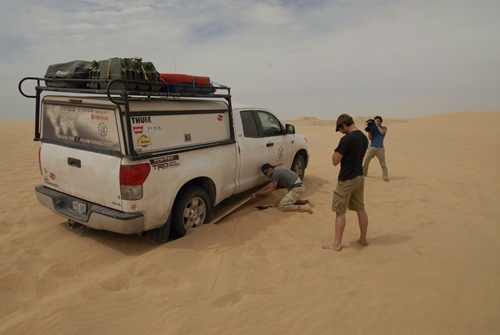
Round one…
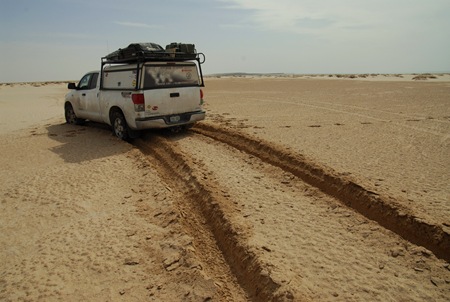
Round two…
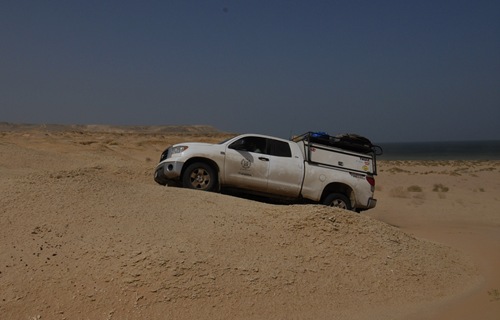
The power of the Thundra actually made our lives a lot easier in the desert
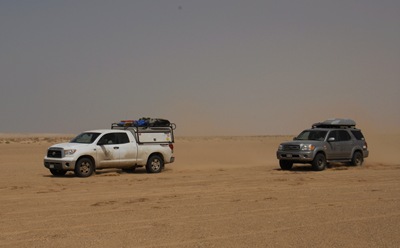
Finding some firmer terrain is always a treat
Digging your car out of the sand is hard work in any conditions, but doing it in the mid-afternoon Sahara sun with temperatures well above 40 degrees (100 degrees F) makes the task even more challenging. Luckily, we had decided to purchase some eight foot sections of wood to use as “sand planks.” When you are driving off-road in the desert, sand planks are an absolute necessity and we soon found out the benefit of spending $25 for some makeshift planks in Nouadhibou. By the time the planks had helped us out of the sand twice over the span of about two hours, I realized that it was probably the best $25 I have ever spent in my life.
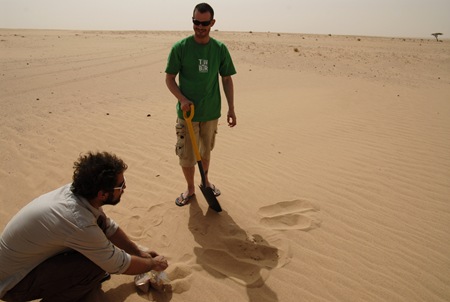
Hopefully the last of the digging… collecting Sahara sand for souvenirs
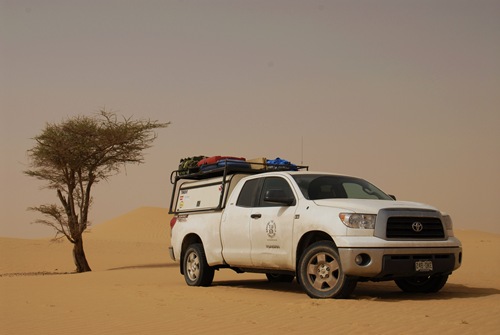
Thundra “Money Shot”
During the next three days, we probably ended up digging the trucks out of the sand at least seven times, and even though the sand planks make the job exponentially easier, I think that by the seventh time, all of us had enough experience getting unstuck to last a lifetime. Even though navigating our way through massive dunes and deceptively soft stretches of sand was a lot of work, it was well worth it. The Sahara Desert has to be one of the most beautiful places I have ever seen. Perfectly sculpted sand dunes stretch as far as the eye can see… real Laurence of Arabia type stuff. It is not too often that you can peer out over an endless stretch of sand and say that you actually drove your truck through it. We also managed to find some dunes to play on and although though the surfing has been fairly flat down most of the North African coast, we at least got to put the boogie boards to good use.
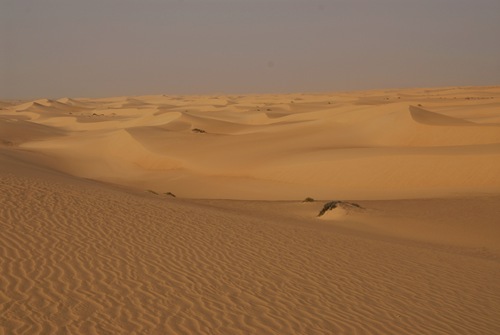
Not many people can claim they drove through terrain like this
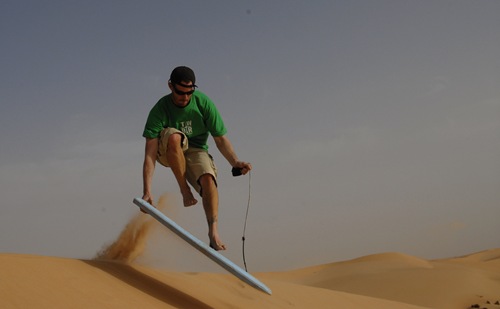
Bouey catches some air off dune number 5783
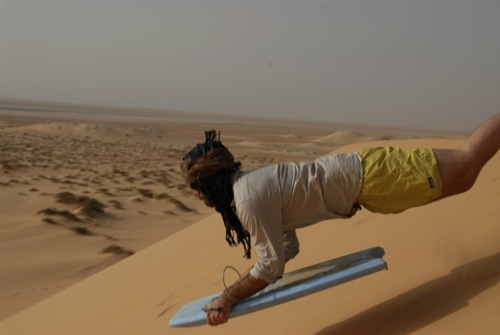
While Shoppman demonstrates how easy it is to knock the wind out of your body
It Is Getting a Little Crowded
By Steven Shoppman in
 It is starting to get a little crowded down here in Africa. The road that is, and it is not necessarily a bad thing. We are quickly finding out that Africa is definitely the place for overland travel and adventure. There are people from all over the world here in North Africa in their desert rigs, custom off-road RV’s and expedition vehicles. In fact, we have probably seen more overlanders in the last few days than we have on the entire expedition combined. In Mongolia, we spotted a couple different groups heading towards Beijing and Shanghai from Europe. In Kyrgyzstan, we met up with the guys from Trabant Trek, and at the ferry depot in Kazakhstan, we ran into a couple of French guys headed east as well, but that was about it.
It is starting to get a little crowded down here in Africa. The road that is, and it is not necessarily a bad thing. We are quickly finding out that Africa is definitely the place for overland travel and adventure. There are people from all over the world here in North Africa in their desert rigs, custom off-road RV’s and expedition vehicles. In fact, we have probably seen more overlanders in the last few days than we have on the entire expedition combined. In Mongolia, we spotted a couple different groups heading towards Beijing and Shanghai from Europe. In Kyrgyzstan, we met up with the guys from Trabant Trek, and at the ferry depot in Kazakhstan, we ran into a couple of French guys headed east as well, but that was about it.
Now, it seems like every day we meet new groups of people. Most seem to be headed in the opposite direction, and although it would be nice to caravan for a while with some other people in the lonely stretches of empty desert, we have been getting some pretty detailed intel about what lies down the road for us. In Dahkla, Morocco, we crossed paths with three South Africans who have been surfing their way up the west coast of Africa for the last 11 months. We soon became good friends with the guys from African Surfer and they passed on a lot of helpful information including assuring us that we would not be disappointed by taking the west coast route.

Tim sets up camp in the African Surfer ’81 Toyota
Here in Nouadhibou, Mauritania, we have also met numerous overlanders headed in all directions. We have been camping with a couple from Germany, learned the complexities of trying to sell a vehicle from a group of kids from Poland, traded stories from the road with another group of South Africans and exchanged GPS coordinates with a couple from France. Everyone has unique experiences and words of advice and encouragement to share with everyone. Even though the stories are different and the words of advice may conflict from time to time, if one thing has remained constant, it has to be the abundance of adventure and the rewards obtained from driving overland in your own vehicle. Nowhere else on the expedition have we met more people who understand why we are doing what we are doing. No one ever has to explain why they are driving overland because everyone already knows. It is a refreshing feeling. Oh yeah, and most of the vehicles happen to be Toyotas…

The Germans get ready to head north into Morocco

If you are in the market for a couple of Land Rovers we know some guys in Mauritania

Some more South Africans arrive on the scene

The SA’s logo is pretty cool

Just another day in expedition-ville central

New Video – Mauri…what?
By Steven Shoppman in
A couple of years ago the TWBR route began to take shape. When first planning a route for a grand voyage like this, the sky is the limit. Countries that you never even knew existed become possibilities; geography becomes a daily topic of conversation. It is quite interesting just how large some countries are that probably 90% of people do not know exist. Mauritania is one of those places. With a population of only 3 million people in just over 1 million square kilometers, this country is a giant desert with large expanses containing very little signs of life. For most of us the Sahara desert is something that we read about in books or hear about in romantic adventure stories while we are growing up.
The last week or so, however, the Sahara desert is the place that we have been calling home and although signs of life are few and far between, they are quite intense when you do find them. A year ago Mauritania was a country that we did not even know how pronounce and was a place that we decided we would not be traveling through. Since our original route became basically impossible as Libya would not issue us visas and Algeria’s borders are closed, Mauritania has officially become our second country in Africa and we could not be more pleased with the new route. The first day we spent here is like no other day on the trip so far. We are staying a town called Nouadhibou, and here there is a ship graveyard with well over 40-50 ships that fill the coastline. Ranging in size from small dinghies to giant industrial ships, the coast has a post apocalyptic feel like something really bad has happened here. The beach is full of all kinds of different trash ranging from the standard plastic bags to pieces of heavy machinery.
The truth, as we have been told, is that the harbor master over the last handful of decades allowed people to decommission their boats for free here. The “decommissioning” process here is to simply leave the boats on the shoreline to rot. Certainly the large amounts of industrial trash and toxins that are released from these boats are not good for the environment, but the spectacle they leave behind is something that all of us will never forget.

Mines are all along the road on the way here.

Some people have taken the trash on as a home.



It is hard to understand how this ended up the way it did.

I heart goggles and turbans
Just to be thorough.
By Steven Shoppman in
Here in the Western Sahara semi-autonomous, free administered territory UN controlled Moroccan owned rebel occupied landmine danger zone surf resort area of the globe, it is really difficult to really tell what is going on. No one really claims this as a country, many people occupy it, laws contradict themselves and roads are actually pretty good here, which would lead you to believe that it is well run. The problem is that it is hard for us to really tell who is running this show.
All of the 8 checkpoints we went through on our way from Boudjour to Dahkla, a span of only 500kms, were managed by soldiers wearing Moroccan uniforms. These men were all very nice and quite friendly, but regularly over the 4-5 hours of time we spent during that day stopped at checkpoints, I wondered how “independent” these checkpoints are. Sometimes we would simply be waived through, other times stopped for as long as 45 minutes. We tried everything from being short with the men to making friends, but overall nothing seemed to really expedite the stops. Since nothing is computerized and many of the checkpoints don’t even have power it is hard to see how this makes anything more secure. We were told recently that they have the checkpoints to make sure that you arrive at the next one. It you do not arrive at the next one, they will search for you as many people have had problematic run-ins with the land mines here. The problem is that I cannot see any search party being sent out, considering that a lot of people pull off to the side of the road to camp here, just like we did the first day. Obviously you would be late arriving to the next checkpoint if you camped for two or three days between them.
Everything is handwritten, nothing is organized, and if these checkpoints are for security, it is hard to see why they waive so many other people by while spending so much time with us. After talking to some of the locals here in Dahkla, we think we have a solution, if we have photocopies of our passports they will take those and send us on our way. I will keep my fingers crossed that this works. The other thing we learned is that being too friendly with the guards will only make your stay longer. These guys are working 100s of kms away from anything in the middle of nowhere, so a little entertainment from the TWBR crew is just what they need to break up their day.
So at the end of the day, 3 Polaroids, 2 t-shirts, a Toyota gorilla, and a pack of cigarettes later we made it through one checkpoint in around an hour instead of a half an hour. We learned our lesson, even if you speak French, you don’t at the checkpoints. Even if you have t-shirts and jokes to tell, you don’t at checkpoints. It was a fun experience and we all had a good time, but from here on out, we are sorry to say, “Border guards, we cannot be friends with all of you.”
Oh and one more thing, thanks to the guard at the second to last stop at 10pm for giving us some fried fish as a gift at checkpoint #7. We liked checkpoint 7:).

For this picture, the extra hour was well worth it. Please note some sort of weapon tucked behind the picture of the king.

8 times in one day…maybe a little excessive?

30 more minutes of my life down the drain, checkpoint #6.
This is the Desert
By Steve Bouey in
Well, we are in the thick of it now. The thick, blowing sand of the Western Sahara Desert. In fact, we are actually in a UN administered territory called Western Sahara. (The Moroccans like to claim it as their southern province and the rebel POLISARIO Front refers to the land as the “free zone.”) Whatever you want to call it, politics aside, it is definitely the desert. It is strange that a place so empty and so seemingly void of life can spark so much interest and arouse so much curiosity in people. On the surface, it does not seem like the desert has much to offer, but nothing can be farther from the truth, and when it comes to things to offer, the Sahara has a full plate to chose from.
Driving through Western Sahara is a bit odd. Obviously there are not too many people living here as daytime temperatures soar well above 40 degrees and plummet to next to nothing after the sun goes down, but signs of people seem to be everywhere. Signs of life come in the form of ramshackle tents distributed quite randomly amongst the rocks and sand dunes. Sings of life come in the form of blown-out tires scattered along the side of the lone road that meanders its way south to Mauritania… there are other tracks further inland, but the risk for exploration is high as landmines have been buried all over the place. Unfortunately, signs of life here in this part of the desert also come in the form of trash which seems to accumulate everywhere. Although the plastic bag may be practical, when you see “plastic bag bushes” hundreds of miles from any form of civilization it makes you wonder if they are really beneficial at all.
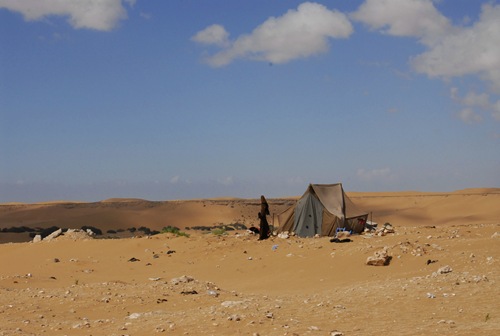
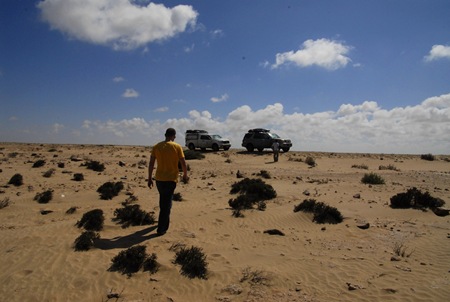
Navigating the trash and hopefully the landmines
Signs of non-human life are even more evident in the desert. Snakes and critters of all types reside here and although they are extremely difficult to spot due to both their camouflage and calculated movements, their tracks can been seen throughout the sand. Underground rivers wind their way through the dunes, completely hidden from view and the only indication that there is water around is the occasional patch of green grass or the even less frequent oasis. No mirages just yet.
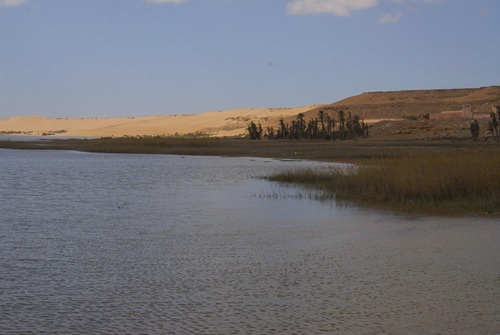
Desert Oasis
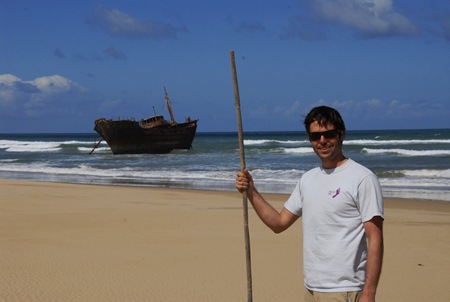
Mark scouts out a shipwreck we spotted from the road
It is a bit cliche, but camels are also part of the desert and the Sahara is no exception. I am not sure if they are completely wild, but camels here freely graze wherever they chose and sometimes that tends to be in the middle of the road. When you come to a place like the Sahara, you hope that you can catch a glimpse of a camel outside of a typical tourist attraction. For us, this glimpse started in the form of concrete structures which gave way to road signs alerting you to their presence to finally seeing live camels roaming about the desert plains in giant herds. I have to admit, camels are a strange breed of animal. There is nothing quite like a camel and there is no other animal I am aware of that communicates by using what sounds like deep, prolonged belching. In any regard, seeing the silhouette of a camel herd grazing against the backdrop of a setting sun in the Sahara desert is up there with one of the coolest things I have seen in my life.
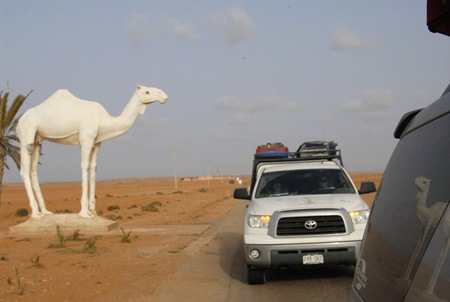
First sign of camels in the desert
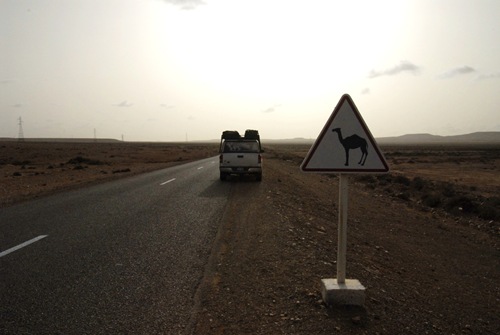
Second sign, literally, of camels in the desert
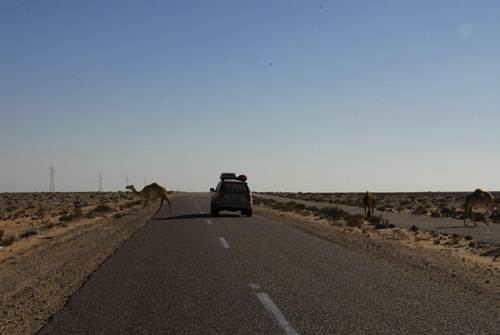
Almost hitting camels in the desert
We have only been in the desert for a few days and the peace and tranquility that you find here can sometimes blind you to the fact that although beautiful in countless ways, the desert can also be a very dangerous and inhospitable place. So far, the desert has been good to us and we can only hope that the trend continues because we still have a long way to drive before the sands of the Sahara start to give way to the lush vegetation of equatorial Africa.
New Video – Fez, Morocco – You have got to try this once in your life.
By Steven Shoppman in
Have you ever done something that was completely unnecessary and totally necessary at the same time? Instances like these can only really be understood in retrospect, but I suppose that is how one might define some of the most memorable experiences in a lifetime. After recently crossing the straights of Gibraltar and officially starting what may prove to be the most intense part of the whole expedition, Morocco has proven to be a place full of color and excitement. The markets, touts, ancient cities and delicious food are enough to keep you occupied for months here and the citizens of this country, although intense at times, are always helping to make each moment more interesting than you planned it to be.
In Fes, the city that Lonely Planet notes at the “Soul of Morocco”, the first impression of walking through the narrow streets of the Medina is something reminiscent of an Indiana Jones like epic, searching for a lost antiquity or mythic scroll that has the answers to all of your questions about life. These narrow streets are far to slender to accommodate a smart car in places, let alone two oversized American trucks. As the Medina’s narrow streets begin widen closer to the city walls, the locals take it upon themselves to fill this extra space with vegetables, car parts, coffee makers, and tons of other goods in a winding loop of a marketplace. Here, although the streets are considerably wider than the streets in the center, they are by no means a thoroughfare to get from one side of the Medina to the other.
The first night that we spent in Fes, we were led to a hotel near the bottom of the Medina by a tout. We were tired when we arrived, so the first night we stayed at the hotel the tout had delivered us to, even though it was booked for the rest of the weekend. The next morning the owner offered to take us to another area of town where we could find another hotel. This was the necessary part of the day. Tasks like these are the makings of a normal day, getting the things done that need to get accomplished that day.
The twist that made this more than just a transfer from one hotel to another was the ingenious idea of our friendly hotel owner to have us take the not so direct route. This route was actually so indirect that it caused us to go in a complete circle from a point we had already passed on the way to the other part of town. Looking back on this incredible experience, it now seems hard to decide whether the necessary part of this incredible day was moving to the new hotel or driving on this longcut. Have a look at this clip and decide for yourself, and then at some point give this a try…
New Video – Casablanca – How not to get a free hotel.
By Steven Shoppman in
Here at The World by Road, we have many different ways of saving money. From the full service kitchen we can setup out of the back of the truck or even sometimes bring with us into the hotel room for late night snacks to the faring we are working on to increase gas mileage, we have many ways to cuts costs across the board. The floorspace in hotel rooms many times is a sea of foam pads and sleeping bags filled with crew members and in some cases like our latest room in Agadir, Morocco, a 4 little bears setup keeps the four of us just an arms reach away all night long in our $22 per night room. We eat local food and sometimes just don’t eat at all. Coca Cola has enough calories to count as a meal, right?

At the end of the day we are still struggling for money and sometimes it is nice to treat ourselves to a top notch hotel to break up the monotony of our streamlined budgeting techniques. At place like the Hyatt or the Hilton, everything is taken care of, and there is something to be said for that. All of the backpackers and self-proclaimed hardcore travelers out there are probably scoffing as they read this, but from time to time it is nice to check into a hotel and when we ask the question of where we can park the cars the immediate answer is, “Where would you like the valet to park them, sir?” The truth is that I prefer to camp over staying in a hotel at all, but in a city where there are security concerns about the cars, a ton of work to do and enough grime caking everything you own to raise concerns with the local health department, a couple of nights on the other side of the tracks is welcome.
Since the beginning of the trip we have been honing our skills on getting everything discounted or free when possible. In Casablanca we may have gotten a little too confident in our skills of persuasion when we approached the Hyatt in the center of downtown with the grandiose idea of getting accommodation for the entire crew at a moments notice, but hey, how do you get better if you do not try for bigger fish?






























